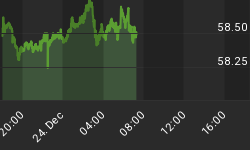Uncertainty over the global economic outlook yesterday took its toll on stock markets around the world as risk aversion favored safe-haven assets such as government bonds, the US dollar and Japanese yen.
In the US, stocks declined to their lowest levels since the end of May as investors await the start of the second-quarter earnings season.
I referred to the CBOE Volatility (VIX) Index in a post yesterday, and specifically to its use as a contrary indicator. The VIX, also known as the "fear index", closed the day 6.4% higher.
All ten US economic sectors fell, confirming a pattern of the defensive-oriented sectors such as utilities, health-care and consumer staples outperforming the cyclical sectors like energy, materials, industrials and consumer discretionary. The chart below shows the performance of the sectors since the high of the S&P 500 Index on June 2, 2009 - a relative pattern as one would typically expect during a corrective phase.

Source: StockCharts.com
The key moving-average levels for the major US indices are given in the table below. The S&P 500 Index yesterday breached the key 200-day line (for the third time in 26 trading days), joining the Dow Jones Industrial Average and the Dow Jones Transportation Index in bearish mode. With the exception of the Nasdaq Composite Index, the indices are also all trading below the 50-day moving average.

Additionally, the Dow Industrial Average and S&P 500 Index also yesterday broke through the "neckline" of a head-and-shoulders formation - a bearish event. For more on this, key levels and the most likely short-term direction of the S&P 500 Index, Adam Hewison of INO.com prepared another of his popular technical analyses.
Click here or on the chart below to access the short presentation.

Turning to Richard Russell, 84-year-old writer of the Dow Theory Letters, the excerpts below cast light on how he sees the lie of the land.
"I've repeated the bearish factors so many times that I hardly have the energy to go over them again.
• The Lowry's studies indicate steady deterioration in the strength of the stock market.
• On top of that, we have the still-operative non-confirmation by the Transports.
• We have the overvaluation from the standpoint of Dow and S&P dividend yields.
• We have the recent breakdown of the Industrials from a head-and-shoulders top formation.
• We have the Dow graded as bearish (it's below 10,725) under the 50% Principle.
• We have NYSE volume tending to contract on days when the market is higher and expand on days when the market is lower.
• We have the market acting poorly in the face of 'brightening' business news and numerous Fed 'green shoots'.
• Above all, the primary trend of the market was last confirmed as bearish under Dow Theory.
We have the majority of analysts insisting that March 9 was the bottom of the bear market. Here I apply contrary opinion.
"'So how will this work out?' I ask myself. The market could just continue to sink with very little in the way of rallying ability, until the March 9 lows are tested and violated. The damn trouble with this market (from the bulls' standpoint) is that it shows no signs of becoming oversold, the Selling Pressure Index just keeps creeping higher, and the Buying Power Index continues to deteriorate. This is one nasty bear market if there ever was one."
The technicals undoubtedly look ugly, and investors will now focus on the second-quarter earnings reports as a test of whether stock prices have run away from fundamental reality. As Randall Forsyth said in yesterday's Barron's: "'Less bad no longer is good enough' has become the new market mantra."
Did you enjoy this post? If so, click here to subscribe to updates to Investment Postcards from Cape Town by e-mail.















